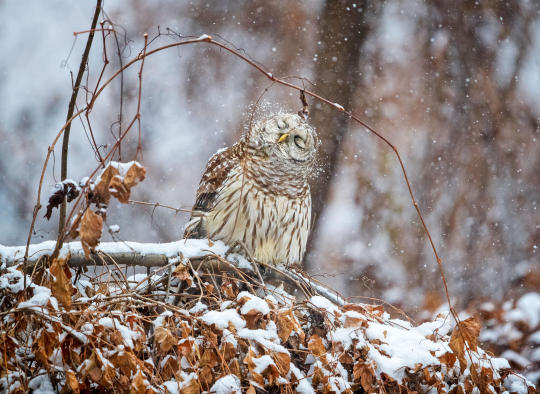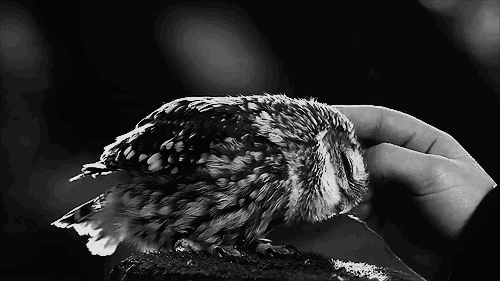#Neel Dhanesha
Quote
Nurdles have a significant impact on the environment long before they are formed, as well. The vast majority of the plastics plants in the United States are located alongside communities of color, which are disproportionately impacted by industrial pollution. Those plants emit a toxic mixture of pollutants including ethylene oxide, styrene, and benzene; there are so many petrochemical plants located between Baton Rouge and New Orleans that the area has become known as “cancer alley.”
Neel Dhanesha, ‘The massive, unregulated source of plastic pollution you’ve probably never heard of’, Vox
#Vox#Neel Dhanesha#Nurdles#United States#plastics plants#communities of color#industrial pollution#ethylene oxide#styrene#benzene#petrochemical plants#Baton Rouge#New Orleans#cancer alley
9 notes
·
View notes
Photo








10 Fun Facts About the Barred Owl
Maniacal laughter. Pink wings. Tree climbing. This bird has a lot going on.
By Neel Dhanesha - Editorial Fellow, Audubon Magazine
February 12, 2021
A large owl of the eastern, central, and, increasingly, northwestern United States, the Barred Owl is one of our more common owl species. As with most owls, the Barred is primarily nocturnal, but it is known to call and hunt during the day. Easily identified by its heavily streaked chest, round, tuftless head, and big, black eyes, the Barred Owl can be found in forested areas throughout its range year-round, including in more urban environments. Read on to learn more about this bird, and when you're done, check out these other fun facts about owls.
1.) If you're out in the woods and hear someone calling who cooks for you, who cooks for you all?, you're actually hearing the distinctive call of the Barred Owl. If you hear what sounds like maniacal laughing afterward, that's usually two Barred Owls performing a courtship duet. Usually.
2.) Barred Owls prefer nesting in tree hollows, but they will also use nests abandoned by other animals, from squirrels to Red-tailed Hawks, and nest boxes located in forest habitat.
3.) These hefty owls can become incredibly territorial once they establish a nest—and especially when they begin rearing chicks. Barred Owls are known to chase away intruders by aggressively hooting or attacking and striking with their talons. (There's even a theory that a Barred Owl was the culprit in a famous murder case.)
4.) Barred Owls prefer mature forests that have both an abundance of prey and trees with cavities. Barred Owls hunt from a perch, where they sit and wait, scanning and listening for prey, and then silently swoop down when they pinpoint their meal.
5.) Barred Owls mostly eat small mammals like mice and voles, but sometimes they go fishing for crayfish and crabs. If a Barred Owl eats enough crayfish, the feathers under its wings can turn pink—just like a flamingo, which gets its hue from the high volume of shrimp in its diet.
6.) Barred Owls are largely sedentary, but in the past century, they have gradually expanded their range. The expansion began west across Canada and then south into the states of the Pacific Northwest, reaching California by the 1980s. This poses a problem for the bird's smaller cousin, the Spotted Owl, which is endangered and also relies on old-growth forests. Barred Owls force Spotted Owls from their territories and can also hybridize with them.
7.) Barred Owls mate for life, and they usually have a single clutch of two or three white eggs each year. During the incubation period, which lasts somewhere between 28 and 33 days, the female sits on the eggs while the male hunts for food.
8.) After they hatch, young Barred Owls can stick around the nest for up to six months, which is unusual for owls. During this time, the young owls rarely stray far from each other and are often seen sitting side by side.
9.) Hatching order often determines chick size: The oldest of a Barred Owl clutch tends to be the largest, with the other chicks being progressively smaller. Adult owls can grow to an impressive 20 inches tall—big enough to terrify an unsuspecting person wandering in the woods.
10.) Chicks leave the nest at four to six weeks old, but they don't go far: Once they leave the nest, these talented climbers clamber about their nest trees (or a nearby tree if they fall to ground), using their bill and talons to grab hold while flapping their wings to keep balance. At 10 to 12 weeks, they begin flying.
Bonus Fact! Historians believe that Harriet Tubman, an avid naturalist, used the Barred Owl’s call as a signal for people seeking to use the Underground Railroad. Depending on the call she used, freedom-seekers would know whether it was okay to come out of hiding.
https://www.audubon.org/news/10-fun-facts-about-barred-owl?utm_source=pocket-newtab
Podcast Hear the Many Different Hoots of the Barred Owl The increasingly common owl has more than a dozen calls, including one that sounds like a monkey.
News Trump Administration Drastically Slashes Protections for Northern Spotted Owls The Interior secretary cut more than one-third from the bird's critical habitat just after his department said it should be listed as endangered.
In The Field A Guide to Finding Urban Owls You don't have to live in the middle of the woods to see an owl. Here's how and where to spot five species in towns and cities across the U.S.
16 notes
·
View notes
Text
Good stuff I read lately
How polyester bounced back, Virginia Postrel, Works In Progress. Where your yoga pants come from. This still doesn't explain why it's so hard to find a sundress that isn't polyester.
'It has to be known what was done to us': Natick couple harassed by eBay tell their story for the first time, Aaron Pressman, The Boston Globe. I somehow missed sharing this last year when I first read it, it's a bonkers story of a corporation attacking its own customers. Now the exec who orchestrated it all is pleading guilty.
The Journalist and the Pharma Bro: Why did Christie Smythe upend her life and stability for Martin Shkreli, one of the least-liked men in the world? Stephanie Clifford, Elle. TV show when?
Kim Blalock Took Lawfully Prescribed Pain Killers During Pregnancy—And Was Charged With A Felony, Cecilia Nowell. Our bodies are already not our own.
The Anti-Abortion Movement’s Next Target: Birth Control: And disinformation from social media influencers is helping their cause. Kiera Butler, Mother Jones. It's terrifying how many women are part of the movement.
The massive, unregulated source of plastic pollution you’ve probably never heard of: “We’re making these nurdles and basically spilling oil, just in a different form.” Neel Dhanesha, Vox. When I was kid I climbed into a train car full of tiny plastic pellets and swam around in them like Scrooge McDuck in his pool of gold. I have always wondered what they actually were. Now I know they were nurdles and while they're destroying the planet, it was harmless for me to swim in them.
1 note
·
View note
Quote
We have laws on the books already that are meant to regulate pollution and emissions from manufacturing and production facilities,” said Anja Brandon, US plastics policy analyst at the Ocean Conservancy, a nonprofit that works to protect oceans and marine life. “Namely in this instance, the Clean Water Act, kind of our bedrock environmental law. These laws haven’t been updated to meet the needs of the moment,” said Brandon. In most of the country, she explained, “plastic nurdles have essentially gotten off scot free because they have yet to be classified or specifically labeled as a pollutant.” The rare exception is California, which in 2007 became the first and so far only state to pass a law classifying nurdles as pollutants to be regulated under the Clean Water Act, citing their contribution to litter on beaches and the possibility that they could be mistaken for food by marine animals.
Neel Dhanesha, ‘The massive, unregulated source of plastic pollution you’ve probably never heard of’, Vox
#Vox#Neel Dhanesha#pollution#production facilities#manufacturing facilities#Ocean Conservancy#Anja Brandon#Clean Water Act#plastic nurdles#California#United States#marine animals
6 notes
·
View notes
Quote
For many marine animals, the smell of the sea is the smell of food. Seabirds like albatrosses and petrels track dimethyl sulfide to locate patches of plankton from afar, swooping down to pluck their plankton-eating prey out of the water. A nurdle is the size and shape of a fish egg; its camouflage is nearly perfect after some time in the water, looking and smelling like easy pickings to fish, birds, turtles, and crustaceans alike. Plastics provide no nutrients to animals, but an animal that fills up on the beads will eat less food as a result, meaning it could starve to death without even knowing it was starving — especially if its digestive tract is too small to pass the nurdle. Photographs from the aftermath of the spill in Sri Lanka showed fish filled with the pellets, white plastic lining their insides.
Neel Dhanesha, ‘The massive, unregulated source of plastic pollution you’ve probably never heard of’, Vox
#Vox#Neel Dhanesha#marine animals#Seabirds#plankton#dimethyl sulfide#nurdle#Plastics#Sri Lanka#plastic spill
2 notes
·
View notes
Quote
Hundreds of fish species — including some eaten by humans — and at least 80 kinds of seabirds eat plastics. Researchers are concerned that animals that eat nurdles risk blocking their digestive tracts and starving to death. Just as concerning is what happens to the beads in the long term: Like most plastics, they do not biodegrade, but they do deteriorate over time, forming the second-largest source of ocean microplastics after tire dust.
Neel Dhanesha, ‘The massive, unregulated source of plastic pollution you’ve probably never heard of’, Vox
2 notes
·
View notes
Quote
A nurdle is a bead of pure plastic. It is the basic building block of almost all plastic products, like some sort of synthetic ore; their creators call them “pre-production plastic pellets” or “resins.” Every year, trillions of nurdles are produced from natural gas or oil, shipped to factories around the world, and then melted and poured into molds that churn out water bottles and sewage pipes and steering wheels and the millions of other plastic products we use every day. An estimated 200,000 metric tons of nurdles make their way into oceans annually. The beads are extremely light, around 20 milligrams each. That means, under current conditions, approximately 10 trillion nurdles are projected to infiltrate marine ecosystems around the world each year.
Neel Dhanesha, ‘The massive, unregulated source of plastic pollution you’ve probably never heard of’, Vox
1 note
·
View note